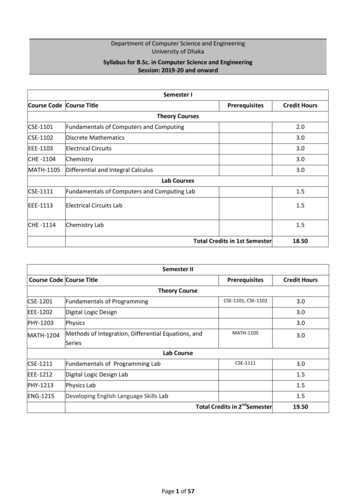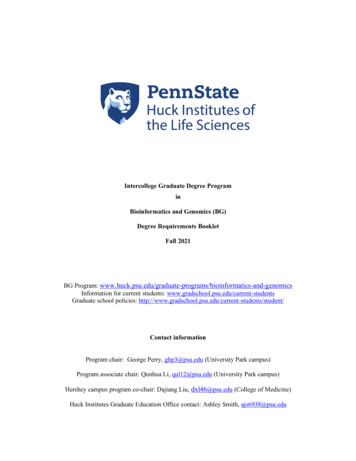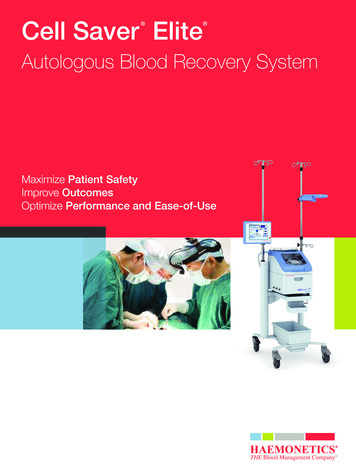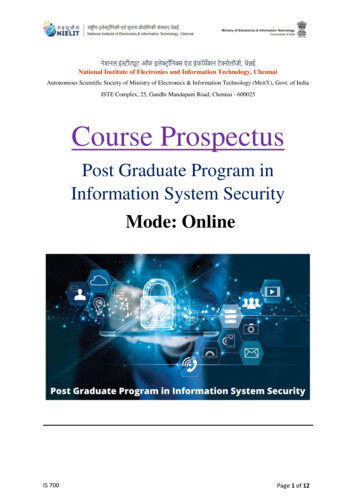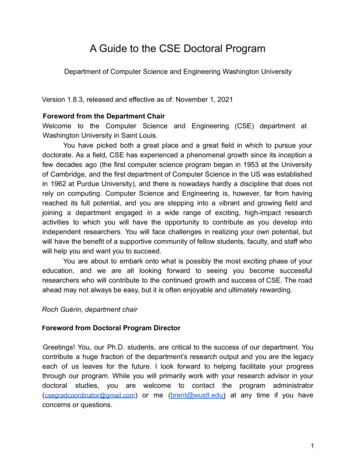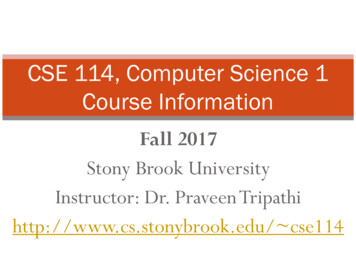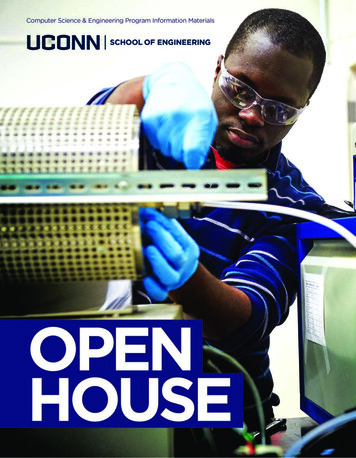
Transcription
COMPUTER SCIENCE& ENGINEERINGInterim Leadership for Fall 2018Reda Ammar, Ph.D.Alexander Russell, Ph.D.Interim Department HeadInterim Associate Department HeadCSE Welcomes New FacultyDerek Aguiar, Ph.D.Assistant ProfessorPh.D., Brown University, 2014derek.aguiar@uconn.edu Probabilistic Modelling Computational Biology Machine Learning AlgorithmsQian Yang, Ph.D.Assistant ProfessorPh.D., Stanford University, 2018qyang@uconn.edu Machine Learning forPhysical Science Computational Math Applied AlgorithmsAhmad Jbara, Ph.D.Assistant Professor in Residence Ph.D., The Hebrew Universityof Jerusalem, 2016ahmad.jbara@uconn.eduProgram Comprehension,Code Complexity MetricsSoftware EngineeringSystems Engineering, Object-ProcessMethodologySecure Usability
A NOTEFROM THEDEPARTMENTHEADThe Department of Computer Science &Engineering (CSE) recently celebrated the 30thanniversary of our establishment as an academicdepartment at the University of Connecticut.Yet the history of computer science at theUniversity actually begins over half a centuryago with the introduction of our first computingcourses in the 1960’s. The first defense of aPh.D. in Computer Science was held in 1967. TheComputer Science curriculum was establishedin 1970, and the program was accredited in 1972among the very first undergraduate programs inthe field of Computer Science. As we enter ournext epoch, Computer Science & Engineeringencompasses broad areas of intellectualdiscourse in informatics spanning a plethoraof educational and research activities rangingfrom the very foundations of computabilityto the challenges of building dependable andsecure computer and cyber-physical systemsthat underlie much of the modern societyendeavors. The department is ever-growing;our undergraduate enrollment has doubled inthe last four years and the number of doctoralstudents exceeds one hundred forthe first time. Our faculty nowincludes more than thirtyfull-time membersfor the first time in our history. Since the start ofthe millennium, the department has experiencedsignificant qualitative evolution, complementingour rigorous educational curricula withcomprehensive research programs in severalareas. Our department has excellent and diversefaculty with research and education expertise inthe traditional and emerging fields of computerscience and engineering. We continue to attracttalented young faculty, with twelve of ourfaculty winning the prestigious National ScienceFoundation Career Awards since the turn ofthe century. Our presence remains strong in thecommunity as we fulfill our mission of research,education, industrial and public outreach, andservice to the profession. I invite you to browseour website at www.cse.uconn.edu where youwill find detailed information on our academicprograms at the undergraduate and graduatelevels, research and teaching profiles of ourfaculty, and student societies. I am confident youwill find a topic that sparks your interest. As youget to know us better do not hesitate to contactus. We will be happy to answer your questions.Sincerely,Alexander A. SchwarzmannDepartment Head
CSE FACULTYREDA A. AMMARProfessor and Director of EngineeringGlobal ProgramsPh.D., University of Connecticut, 1983reda@engr.uconn.edu Performance EngineeringUnderwater Computer SystemsBig Data AnalyticsReal-time Distributed SystemsBENJAMIN FULLERAssistant ProfessorPh.D., Boston University, 2015benjamin.fuller@uconn.edu KUL S. BANSALSWAPNA S. GOKHALEAssistant ProfessorPh.D., Iowa State University, 2009mukul.bansal@uconn.eduAssociate ProfessorPh.D., Duke University, 1998ssg@engr.uconn.edu Social Media Software Engineering Performance and Dependability AnalysisComputational Biology and BioinformaticsComputational Molecular EvolutionCombinatorial OptimizationAlgorithmsKEITH BARKERSONG HAN Computer Science Education Curriculum and Technology Development Instructional Design ProfessorUniversity Teaching FellowPh.D., Sheffield University, 1966keith.barker@uconn.eduJINBO BIAssociate ProfessorPh.D., Rensselaer Polytechnic Institute, 2003jinbo@engr.uconn.edu Machine LearningStatistical Data MiningLarge Scale OptimizationBiomedical InformaticsPHILLIP BRADFORDAssociate Professor in-ResidenceDirector of Computer Science,Stamford Regional CampusPh.D., Indiana University, 1995phillip.bradford@uconn.edu Applied Algorithms, Optimization andMachine Learning Security, Programming Languages, Data Analytics Computational Finance, Auctions,Bitcoin/BlockchainAssistant ProfessorPh.D., University of Texas, Austin, 2012song@engr.uconn.eduCyber-Physical SystemsReal-Time and Embedded SystemsLarge-Scale Real-Time Data ManagementWireless Networks and Mobile ComputingAMIR HERZBERGProfessor and Comcast Chairfor Security InnovationD.Sc., Technion-Israel Institute of Technology, 1991amir.herzberg@uconn.edu Security and Privacy for Internet and beyond Applied Cryptography Secure Usability and Human-Computer InteractionCHUN-HSI HUANGAssociate ProfessorPh.D., State University of New York at Buffalo, 2001huang@engr.uconn.edu Graph AlgorithmsParallel ComputingCluster/Grid ComputingBioinformaticsJOSEPH JOHNSONAssociate Professor in-ResidencePh.D., Nova Southeastern University, 2002augusto.casas@uconn.eduAssociate Professor in-ResidenceAssociate Director of Undergraduate Programsin ComputingPh.D., Rensselaer Polytechnic Institute, 2016joseph.2.johnson@uconn.edu Computational Finance Financial Planning Informatics Legal Informatics Computational Semantics Knowledge Representation and Reasoning Natural Language Processing, Machine LearningSTEVEN A. DEMURJIANMOHAMMAD MAIFI HASAN KHANC. AUGUSTO CASASProfessorPh.D., The Ohio State University, 1987steve@engr.uconn.edu Role-based, Discretionary,and Mandatory Access Control Mobile and Cloud Computing with Access Control Secure Software Engineering Software Architectures for Biomedical InformaticsPARASARA SRIDHAR DUGGIRALAAssistant ProfessorPh.D., University of Illinois, Urbana-Champaign, 2015psd@engr.uconn.edu Verification of Cyber-Physical SystemsFormal Methods and VerificationControl TheorySoftware VerificationAssistant ProfessorPh.D., University of Illinois,Urbana-Champaign, 2011maifi.khan@engr.uconn.edu Performance Analysis of Large Scale Systems Design of Dynamic Data DrivenApplication Systems Human-Machine InteractionWALTER O. KRAWECAssistant ProfessorPh.D., Stevens Institute of Technology, 2015walter.krawec@uconn.edu Quantum Cryptography and Communication Computer Security Information Theory
ION MANDOIUALEXANDER C. RUSSELL Computational Complexity Cryptography Distributed ComputingProfessorPh.D., Georgia Institute of Technology, 2000ion@engr.uconn.eduApproximation AlgorithmsCombinatorial OptimizationBioinformaticsComputational GenomicsROBERT MCCARTNEYAssociate Professor and Director ofUndergraduate Computing EducationPh.D., Brown University, 1988robert@engr.uconn.edu Computing EducationInformal and Self-directed LearningCommonsense ComputingArtificial IntelligenceProfessor and Director of the Graduate ProgramPh.D., Massachusetts Instituteof Technology, 1996acr@cse.uconn.eduDONALD SHEEHYAssistant ProfessorPh.D., Carnegie Mellon University, 2011donald@engr.uconn.edu Computational Geometry Mesh Generation Topological Data AnalysisZHIJIE “JERRY” SHIJEFFREY A. MEUNIERLecturer and Coordinator ofFreshman Computing EducationM.S., University of Connecticut, 1999jeffm@cse.uconn.edu Computer Science Education Microcontrollers, Automation, Robotics Programming Languages and Abstract MachinesFEI MIAOAssistant ProfessorPh.D., University of Pennsylvania, 2016fei.miao@uconn.edu Cyber-Physical Systems Autonomous Transportation Systems Optimization and ControlAssociate ProfessorPh.D., Princeton University, 2004zshi@engr.uconn.edu Computer SecuritySensor NetworksComputer ArchitectureEmbedded SystemsDONG-GUK SHINProfessorPh.D., University of Michigan, 1985shin@engr.uconn.edu BioinformaticsVisual User InterfacesBiomedical Big Data AnalysisIntelligent Software AgentsDatabase InteroperationLAURENT MICHEL Combinatorial OptimizationConstraint Programming/Local SearchSecurity/VotingProgramming LanguagesArtificial IntelligenceALEXANDER A. SCHWARZMANNProfessor and Department HeadPh.D., Brown University, 1992aas@cse.uconn.edu Distributed Computing and Fault ToleranceElectronic Voting Systems and SecurityParallel and Distributed AlgorithmsFormal Specification and ModelingSHEIDA NABAVIAssistant ProfessorPh.D., Carnegie Mellon University, 2008nabavi@engr.uconn.edu Statistical Machine LearningComputational GenomicsSignal/Image ProcessingTranslational BioinformaticsBING WANGProfessorPh.D., University of Massachusetts, 2005bing@engr.uconn.edu Computer Networks Multimedia Distributed SystemsTOM PETERSProfessorPh.D., Wesleyan University, 1982tpeters@engr.uconn.edu Computational TopologyComputer Aided Geometric DesignComputational GeometryDesign TheoryWEI WEIAssistant Professor in-ResidencePh.D., University of Massachusetts, 2006wei.wei@uconn.edu Computer Networks Social Networks Performance EvaluationSANGUTHEVAR RAJASEKARANYUFENG WU Computational Biology Bioinformatics AlgorithmsThe UTC Chair Professor, BECAT DirectorPh.D., Harvard University, 1988rajasek@engr.uconn.eduApplied AlgorithmsBioinformatics and Computational BiologyBig Data AnalyticsHigh Performance and Parallel ComputingAssociate ProfessorPh.D., University of California, Davis, 2007ywu@engr.uconn.eduUCONN SCHOOL OF ENGINEERINGProfessor and Associate Department HeadPh.D., Brown University, 1999ldm@engr.uconn.edu
OURPROGRAMSUNDERGRADUATE DEGREEOur undergraduate program provides a breadth of instructionin computer science and engineering, while allowing thestudents to gain a depth of knowledge in particular technicalareas of interest. The curriculum provides sufficient work inmathematics, science, and engineering allowing students todesign solutions to a wide variety of problems. Coursework inthe humanities and social sciences are an integral part of theengineering program to make students aware of their socialresponsibility and to consider non-technical factors in thepractice of engineering.AT THE UNDERGRADUATE LEVEL WE OFFER: B.S. in Engineering with a major in Computer Scienceand Engineering * B.S. with a major in Computer Science B.S. in Engineering with a major in Computer Engineering*,offered jointly with the Electrical and ComputerEngineering Department* Accredited by the Engineering Accreditation Commissionof ABET, http://www.abet.org. Accredited by the Computing Accreditation Commissionof ABET, http://www.abet.orgAs part of the Bachelor’s Degrees in Computer Scienceand Engineering and Computer Science, students completea concentration in one of the following areas: Theoryand Algorithms, Systems and Networks, Cybersecurity,Bioinformatics, Software Design and Development, Computational Data Analytics, Unspecialized or Individually Designed.GRADUATE DEGREESOur graduate program is a flourishing international communityof scholars, consisting of faculty and students from around theworld. Graduate degrees prepare students for advanced workor research careers in academia or industry.AT THE GRADUATE LEVEL WE OFFER: Master of Science in Computer Science and Engineering,with both course and thesis options. The course-basedprogram is intended as either a terminal degree whichprepares students for advanced work in industry, or aspreparation for Ph.D. studies. The thesis-based program isspecifically intended to prepare students for research andPh.D. studies. Doctor of Philosophy in Computer Science and Engineering.The Ph.D. degree prepares students for a career in research,either in industry or academia.Our graduate students are routinely supported by fellowships,research assistantships, or teaching assistantships. Our graduates are in constant demand, both by academia and industry.Alexander A. SchwarzmannDepartment HeadLaurent MichelAssociate Department HeadComputer Science & EngineeringUniversity of Connecticut371 Fairfield Way, Unit 4155Storrs, CT 06269-4155Phone: (860) 486-3719Email: engr-csoffice@uconn.eduThe Information TechnologiesEngineering (ITE) Buildingis home to the Computer Science & Engineering and Electrical& Computer Engineering departments. This 110,000 squarefoot high-tech gem houses a 350-seat auditorium, classrooms,an extensive learning center, specialty training facilities and someof the most innovative research labs in the country for advancingcutting-edge engineering technology. CSE research labs locatedin the ITE building cover a broad spectrum of research activities.This includes Artificial Intelligence, Bioinformatics, Big Data,Computer Systems, Cyber-Security, Distributed Computing,Machine Learning, Software Engineering, Theoretical Foundations,and Voting Technology.ADJUNCT FACULTYTERRY G. GLAGOWSKIAdjunct FacultyPh.D., University of Connecticut, 1984glagowski@engr.uconn.edu Software Methodology Software Tools Embedded SystemsDINA GOLDINAssociate Professor in-ResidencePh.D., Brown University, 1996dina.goldin@uconn.edu Efficient Querying of Non-Traditional Data Models of Interactive Computation Software Architecture for Online andSensor-based SystemsGREGORY JOHNSON, JR.Visiting InstructorM.S., University of Connecticut, 2003greg.johnson@uconn.edu Constraint Programming Discrete Optimization Computer Security
A NOTEFROM THEDEPARTMENTHEADThe Department of Computer Science & Engineering (CSE) recently celebratedthe 30th anniversary of our establishment as an academic department at theUniversity of Connecticut. Yet the history of computer science at the Universityactually begins over half a century ago with the introduction of our firstcomputing courses in the 1960’s. The first defense of a Ph.D. in ComputerScience was held in 1967. The Computer Science curriculum was establishedin 1970, and the program was accredited in 1972 among the very firstundergraduate programs in the field of Computer Science. As we enter our nextepoch, Computer Science & Engineering encompasses broad areas of intellectualdiscourse in informatics spanning a plethora of educational and research activitiesranging from the very foundations of computability to the challenges of buildingdependable and secure computer and cyber-physical systems that underliemuch of the modern society endeavors. The department is ever-growing; ourundergraduate enrollment has doubled in the last four years and the numberof doctoral students exceeds one hundred for the first time. Our faculty nowincludes more than thirty full-time members for the first time in our history.Since the start of the millennium, the department has experienced significantqualitative evolution, complementing our rigorous educational curricula withcomprehensive research programs in several areas. Our department has excellentand diverse faculty with research and education expertise in the traditional andemerging fields of computer science and engineering. We continue to attracttalented young faculty, with eleven of our faculty winning the prestigiousNational Science Foundation Career Awards since the turn of the century. Ourpresence remains strong in the community as we fulfill our mission of research,education, industrial and public outreach, and service to the profession. I inviteyou to browse our website at www.cse.uconn.edu where you will find detailedinformation on our academic programs at the undergraduate and graduate levels,research and teaching profiles of our faculty, and student societies. I am confidentyou will find a topic that sparks your interest. As you get to know us better donot hesitate to contact us. We will be happy to answer your questions.Sincerely,Alexander A. SchwarzmannDepartment Head
DEPARTMENT OF COMPUTER SCIENCE & ENGINEERINGFEATURESAlexander A. SchwarzmannDepartment HeadLaurent MichelAssociate Department HeadRobert McCartneyDirector of UndergraduateComputing EducationAlexander C. RussellDirector of theGraduate Program2About Us3Our Programs4Bansal Honored with NSF CAREER Award4ALUMNI UPDATE: Brittany Nkounkou5DNA Sequencing Technology6STUDENT GROUPS: Association for Computing Machinery6CSE External Advisory Board7Understanding Addiction: A Genetic Approachto Clinical Symptoms8Alumnus Scott Case Inspires Graduates9Making Sense of Big DataJoy BillionLara ChiaveriniJosh GarveyWriters10CSE Faculty Profiles12ACADEMIC ADVISING: Dana ZiterChristopher LaRosaDesign12Lecturers & In-Residence Faculty13ALUMNI UPDATE: Carleton Coffrin13New Curricular Structure for Computing Majors14Cyber Security15Digital Logic Design15ALUMNI UPDATE: Ashley Dumaine16Academy of Distinguished Engineers and Hall of Fame17Voting Technology Research18Upsilon Pi EpsilonThis brochure is published for the alumni, faculty,students, corporate supporters and friends of theDepartment of Computer Science & Engineeringat the University of Connecticut. Suggestionsand information are always welcome. Please sendcorrespondence and address corrections to theaddress below or email aas@engr.uconn.edu.Computer Science & EngineeringUniversity of Connecticut371 Fairfield Way, Unit 4155Storrs, CT 06269-4155P: (860) 486-3719F: (860) 486-48171
ABOUT USTHE INFORMATION TECHNOLOGIESENGINEERING (ITE) BUILDINGis home to the Computer Science &Engineering and Electrical & ComputerEngineering departments. ITE housesan extensive learning center, specialtytraining facilities and some of the mostinnovative research labs in the countryfor advancing cutting-edge engineeringtechnology.This 110,000 sq. ft. high-tech gem issituated between the Homer BabbidgeLibrary and School of Business buildingat central campus. The concourse levelholds teaching labs, along with a 350seat auditorium. Classrooms and a largecomputing learning center are foundon the groundlevel first floor.Administrativeoffices, facultyoffices andresearch labs ofthe ComputerScience &EngineeringDepartment occupy the second floor.Similarly, the fourth floor is occupied bythe Electrical & Computer EngineeringDepartment. The intervening third floorboasts an executive conference room,research labs, spillover faculty offices anda faculty lounge.CSE research labs located in theITE building cover a broad spectrum ofresearch activities. This includes ArtificialIntelligence, Bioinformatics, DistributedComputing, Computer Systems, Security,Software Engineering, TheoreticalFoundations and Voting Technology.2THE COMPUTER SCIENCE &ENGINEERING DEPARTMENThas a long tradition of being at theforefront of computing education at theUniversity of Connecticut. During the1960’s, computer science emerged asan increasingly vibrant and importantarea within the Electrical EngineeringDepartment. The computer sciencecurriculum was established in 1970,culminating the efforts of many facultymembers led by Dr. Taylor L. Booth(1933-1986), a renowned pioneer incomputer science education who isrightly considered to be the founder ofour department. In 1972, the AccreditingBoard for Engineering and Technology(ABET) reviewed UConn’s programand designated it as one of the veryfirst accredited programs in the field ofComputer Science. In the early 1980’s,the major was renamed Computer Scienceand Engineering. Growth in the numberof Computer Science and Engineeringmajors and faculty, and the success of oureducational and research programs, led tothe establishment of a separate ComputerScience & Engineering Department in theSchool of Engineering in 1986. This made2016 an important anniversary for CSE,as the Department celebrated its 30thanniversary and the larger School ofEngineering celebrated its centennialanniversary.The CSE program was the secondprogram to receive dual accreditation fromthe Engineering Accreditation Commission(EAC) of ABET and Computer ScienceAccreditation Commission (CSAC) ofthe Computer Science Accrediting Board(CSAB) in 1993. Two undergraduateprograms were added in 1999, a B.S. witha major in Computer Science and a B.S.in Engineering with a major in ComputerEngineering. The B.S. with major inComputer Science was accredited by theComputing Accreditation Commission ofABET in 2000, the B.S. in Engineeringwith a major in Computer Engineeringwas accredited by the EAC of ABETin 2006. Since the merger of CSABand ABET in the early 2000’s, the CSEdegree has been jointly accredited by theEngineering and Computing AccreditationCommissions of ABET.CSE continues to grow and establishitself with national and internationalvisibility in education and research.During the 21st century, we have seencontinued success with a number ofNational Science Foundation Early CareerDevelopment (CAREER) Awards forCSE faculty, and collaborations withgovernment and industry partners in avariety of laboratories and centers. Alongwith successful faculty research andpartnerships, the department attracts astrong interest from incoming studentslooking to pursue computer science andengineering careers.
OURPROGRAMSUNDERGRADUATE DEGREEOur undergraduate program provides a breadth of instructionin computer science and engineering, while allowing thestudents to gain a depth of knowledge in particular technicalareas of interest. The curriculum provides sufficient work inmathematics, science, and engineering allowing students todesign solutions to a wide variety of problems. Coursework inthe humanities and social sciences are an integral part of theengineering program to make students aware of their socialresponsibility and to consider non-technical factors in thepractice of engineering.AT THE UNDERGRADUATE LEVEL WE OFFER: B.S. in Engineering with a major in Computer Scienceand Engineering * B.S. with a major in Computer Science B.S. in Engineering with a major in Computer Engineering *,offered jointly with the Electrical and ComputerEngineering Department* Accredited by the Engineering Accreditation Commissionof ABET, http://www.abet.org. Accredited by the Computing Accreditation Commissionof ABET, http://www.abet.orgAs part of the Bachelor’s Degrees in Computer Scienceand Engineering and Computer Science, students completea concentration in one of the following areas: Theoryand Algorithms, Systems and Networks, Cybersecurity,Bioinformatics, Software Design and Development, Computational Data Analytics, Unspecialized or Individually Designed.GRADUATE DEGREESOur graduate program is a flourishing international communityof scholars, consisting of faculty and students from around theworld. Graduate degrees prepare students for advanced workor research careers in academia or industry.AT THE GRADUATE LEVEL WE OFFER:Photos: Ashley Dumaine demonstrates amind-controlled project with an EEG headsetduring Senior Design Demonstration Day.Read more about Ashley on page 15. Master of Science in Computer Science and Engineering,with both course and thesis options. The course-basedprogram is intended as either a terminal degree whichprepares students for advanced work in industry, or aspreparation for Ph.D. studies. The thesis-based program isspecifically intended to prepare students for research andPh.D. studies. Doctor of Philosophy in Computer Science and Engineering.The Ph.D. degree prepares students for a career in research,either in industry or academia.Our graduate students are routinely supported by fellowships,research assistantships, or teaching assistantships. Our graduates are in constant demand, both by academia and industry.3
Bansal Honored withNSF CAREER AwardAssistant Professor Mukul Bansal’sresearch interests are in computationalbiology and bioinformatics, with a focuson computational molecular evolution.He specializes in the development ofsophisticated computational methods,efficient algorithms, and powerful softwaretools that can make use of large genomicdatasets to understand the evolution ofgenes, genomes and species. Evolution isfundamental to our modern understandingof biology and an improved understandingof evolution is crucial for deciphering howgenes and genomes function.The Computational Biology researchlab led by Dr. Bansal, is currently engagingin the development of new computationalalgorithms for inferring the evolutionof microbial genomes and gene familiesto understand how microbes evolveand adapt. This research has importantimplications for downstream comparativeand functional genomic analyses ofmicrobes.Dr. Bansal was recently awarded theprestigious NSF CAREER award forresearch on protein domains. Proteindomains are well-characterized functionalconstituents of genes that can beindependently lost or gained duringevolution. Domain shuffling is one ofthe primary mechanisms through whichgenes evolve and gain new functions.Proper inference and accounting ofdomain-level evolutionary events iscrucial to understanding how genes evolveand function, but existing approachesfor studying gene evolution ignoredomain-level events. The newly fundedresearch will form the methodologicaland algorithmic foundations for a novelcomputational framework that will addressthis critical problem and benefit almost allareas of biology.In the figure above, the leaves of the tree, labeled P, Q,R and S, each represent extant genes from the same genefamily, i.e., they all descended from the same ancestralgene, represented by the root (top) of the tree. Eachcolored square, triangle, and circle represents a domainfrom a distinct domain family. The figure shows howthe different genes, during the course of their evolutionstarting from the common ancestral gene, can gain newdomains through duplication or transfer from othergenes and lose existing domains.4ALUMNI UPDATEBrittany NkounkouBrittany Nkounkou, B.S.E. in ComputerScience and Engineering, graduated fromUConn in 2012, Summa Cum Laude withhonors. A Day of Pride Scholar, Brittany wasalso named a Babbidge Scholar, awarded theSchool of Engineering (SoE) OutstandingSenior Women Academic AchievementAward, and was recognized by the Connecticut General Assembly for her scholarship.MY LIFE AS AN UNDERGRADUATEENGINEERING STUDENT ATUCONN WAS GENUINELY GREAT.Brittany is now pursuing a Ph.D. inComputer Science from Cornell University,concentrating on Programming Languagesand minoring in Electrical Engineering.During Brittany’s years at UConn, sheparticipated in the SoE BRIDGE program,tutored at the Undergraduate TutoringCenter, graded coursework for the CSEDepartment and published research throughthe Bio-Grid Research Experience forUndergraduates program. She also played flagfootball and volleyball intramural sports.“My life as an undergraduate engineeringstudent at UConn was genuinely great.I grew so much as an individual, both academically and beyond, and had a lot of funalong the way. While the list goes on, mymost meaningful experiences include longnights at the tutoring center helping studentswith homework, traveling to Hong Kong topresent a research paper I helped publish,and obtaining a paid summer internshipdirectly related to my major. I enjoyed studybreaks on Horsebarn Hill, delicious DairyBar ice cream, karaoke at the Student Unionevery Friday night, and going snowboardingfor the first time at a great rate. All of this wasmade possible by UConn. Students Today,Huskies Forever!”
SEQUENCING TECHNOLOGYDNARecent advances in genomics research havebeen heralding the arrival of personalizedmedicine. The cost for DNA sequencingtechnology will soon be affordableenough for hospitals and clinics to usepatient’s genomic information to diagnosediseases and tailor treatment optionsfor individual patients. Applying thesequencing technology for human health isa transformative information science.There is one clear challenge facing thetechnology’s future advancement; how toanalyze and interpret the massive amountof data contained within our genomes, eachwith 3 billion base units of DNA. Unlessthe data is properly organized, digested andpresented in a manner that becomes clear tohealth care providers, insurance companiesand the general public, the anticipatedsweeping changes may not occur.Dr. Dong-Guk Shin’s research focuseson multiple aspects of solving this genomicsbig data problem. The research includeshow to identify structural variations withinan individual’s whole genome sequences,how to interpret gene expression patternsobtainable from the patient’s RNASequencing data, and how to help scientistsand practitioners conveniently use thedigested information with user-friendlysoftware.Dr. Shin had an opportunity to spenda one year sabbatical leave during 2015at JAX Genomic Medicine (JAX GM) inFarmington, Connecticut, working withthe internationally renowned humangeneticist Dr. Charles Lee. One of Dr. Shin’saccomplishments during his sabbaticalleave included developing an automatedstructural variation discovery pipeline,called fusorSV, and a visual pathwayanalysis system, called TOPAS. The formersystematically combines decisions frommultiple structural variations, callingmethods into a cohesive set of structuralvariation calls, exploiting the strengthsof each caller. The latter is a biologicalpathway visualization system which enablesgenome scientists to analyze newly acquiredexperimental data against gene regulatorydata, curated and organized into a topologyof interacting gene/protein networks.A future direction of Dr. Shin’s researchis studying how the functionalities of thetwo systems, fusorSV and TOPAS, can becombined so that scientists and practitionerscan examine genomics-based humanhealth monitoring in a speedy and seamlessmanner.Dr. Espy Anguiano explains the capabilities ofthe PAC Bio Sequencing Machine operatingat JAX Genomic Medicine, which is knownas one of the most powerful commerciallyavailable DNA sequencers to Dr. Shin.5
STUDENT GROUPSAssociation forComputing MachineryCSE ExternalAdvisory BoardThe Computer Science & EngineeringExternal Advisory Board (EAB) consistsof leaders from industry, government andacademia. The board provides input abouthow the department can g
benjamin.fuller@uconn.edu Cryptography Security Information-Theory Complexity SWAPNA S. GOKHALE Associate Professor Ph.D., Duke University, 1998 ssg@engr.uconn.edu Social Media Software Engineering Performance and Dependability Analysis SONG HAN Assistant Professor Ph.D., University of Texas, Austin, 2012 song@engr .
